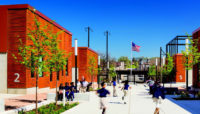When More Is Less
As arts institutions evolve, building bigger is not always better.
We also explore in this issue two performing-arts centers and a new museum. Arts facilities are compelling building types; they give architects an opportunity to experiment with creative solutions'see Dominique Perrault's Albi Grand Theater—and their designs often have a powerful impact on the urban realm. As arts institutions evolve, we tend to focus keenly on how the adaptation or expansion of such significant buildings will affect the public and the city.
Among museums, the trend is to expand or build anew—think of the Los Angeles County Museum of Art or the Whitney, which has just closed its historic Marcel Breuer building to move into a Renzo Piano-designed building in downtown Manhattan next spring. But bigger is not necessarily better. For some arts organizations, expansions run counter to both their core mission and the larger public good. That's why a controversial proposal to add significantly to the Frick Collection in New York is gaining heated opposition.
The Frick is a rare gem of a museum'a world-class collection of art, housed in an unusually calm and intimate setting. Designed by Carrère and Hastings (architects of the New York Public Library) in 1914 for the Gilded Age tycoon and collector Henry Clay Frick, the mansion remained in his family after his death in 1919, opening as a museum in 1935, as he had intended. To transform the house for the public, it was adapted and somewhat expanded by John Russell Pope (architect of Washington's National Gallery of Art), who used space once occupied by a carriage pavilion to create the serene interior courtyard that is the centerpiece of the museum. Overall, its elegant and subdued atmosphere—famously, children under 10 are not allowed—makes it an extraordinary setting in which to contemplate masterpieces by Vermeer, Constable, Ingres, Turner, and Bellini, among the 1,100 works in the collection.
Since the Frick's trustees unveiled a proposed expansion in June, nearly 3,000 people have joined to oppose it by signing an online petition (unitetosavethefrick.org). Designed by Davis Brody Bond, the six-story addition, in a style meant to ape Carrère and Hastings's neoclassical mansion, is clunky and overscaled and would loom over the landmarked museum. It also would mean the destruction of an exquisite small viewing garden, created by the great British landscape architect Russell Page, which Charles Birnbaum of the Cultural Landscape Foundation has called "a master class in restrained minimalism." Too often in the fight for architectural preservation, significant landscapes are overlooked (the highly lauded redesign of the public spaces of Lincoln Center in New York, for example, included ruining the beautifully serene North Plaza by Dan Kiley that was integral to the original architecture).
Just as important as such tangible losses is the more elusive threat to the visitor experience. Should the intimacy of the Frick be risked to create the de rigueur amenities of a mega-museum? Does this unique place really need a better café and bigger bookstore to sell more Vermeer mugs and Turner tote bags? Is there another imaginative way to gain gallery space without such an insensitive expansion?
To get some ideas, just look 20 blocks north along Fifth Avenue, to the mansion built in 1902 by Frick's business friend and rival, the steel magnate Andrew Carnegie. Since 1976, the landmarked mansio—'highly innovative in its day, as the first steel-framed private residence in America—has been home to the Cooper Hewitt, Smithsonian Design Museum. This month, after a three-year-long renovation and restoration, it will reopen with more gallery space—and, yes, visitor amenities—that did not require expansion into the beautiful garden that has existed since Carnegie's day and is now open to the public. The Cooper Hewitt, though a very different type of museum, made some hard choices that the Frick is grappling with, including moving some back-of-house functions off-site or to adjacent townhouses. The museum has maintained the integrity of the Carnegie landmark while enhancing the visitor experience—an object lesson in how to create more room for art while keeping alive the enduring spirit of a historic place.



